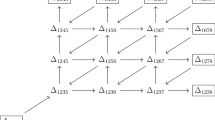Abstract
We survey various generalizations of braid groups for quivers with superpotential and focus on the cluster braid groups, which are introduced in a joint work with King (2018). Our motivations come from the study of cluster algebras, Calabi-Yau categories and Bridgeland stability conditions.
Similar content being viewed by others
References
Brav C, Thomas H. Braid groups and Kleinian singularities. Math Ann, 2011, 351: 1005–1017
Bridgeland T. Stability conditions on triangulated categories. Ann of Math (2), 2007, 166: 317–345
Bridgeland T, Smith I. Quadratic differentials as stability conditions. Publ Math Inst Hautes Etudes Sci, 2015, 121: 155–278
Buan A, Qiu Y, Zhou Y. Decorated marked surfaces III: The derived category of a decorated marked surface. ArX-iv:1804.00094, 2018
Derksen H, Weyman J, Zelevinsky A. Quivers with potentials and their representations, I: Mutations. Selecta Math (NS), 2008, 14: 59–119
Farb B, Margalit D. A Primer on Mapping Class Groups. Princeton Mathematical Series, vol. 49. Princeton: Princeton University Press, 2012
Fomin S, Shapiro M, Thurston D. Cluster algebras and triangulated surfaces, I: Cluster complexes. Acta Math, 2008, 201: 83–146
Fomin S, Zelevinsky A. Cluster algebras I: Foundations. J Amer Math Soc, 2002, 15: 497–529
Gaiotto D, Moore G, Neitzke A. Wall-crossing, Hitchin systems and the WKB approximation. Adv Math, 2013, 234: 239–403
Ginzburg V. Calabi-Yau algebras. ArXiv:math/0612139, 2006
Grant J, Marsh R. Braid groups and quiver mutation. ArXiv:1408.5276, 2014
Guaschi J, Juan-Pineda D. A survey of surface braid groups and the lower algebraic K-theory of their group rings. In: Handbook of Group Actions, vol. II. Advanced Lectures in Mathematics, vol. 32. Boston: Int Press, 2015, 23–75
Ikeda A, Qiu Y. q-stability conditions on Calabi-Yau-X categories and twisted periods. ArXiv:1807.00469, 2018
Ikeda A, Qiu Y. q-stability conditions via q-quadratic differntials for Calabi-Yau-X categories. ArXiv:1812.00010, 2018
Ishii A, Ueda K, Uehara H. Stability conditions on an-singularities. J Differential Geom, 2010, 84: 87–126
Keller B. Representation Theory Cluster algebras, quiver representations and triangulated categories. ArXiv:0807.1960, 2008
Keller B, Van den Bergh M. Deformed Calabi-Yau completions. J Reine Angew Math, 2011, 654: 125–180
King A, Qiu Y. Twisted surfaces and clusters of curves. https://doi.org//people.bath.ac.uk/masadk/zzz/cc-new.pdf, 2014
King A, Qiu Y. Exchange graphs and Ext quivers. Adv Math, 2015, 285: 1106–1154
King A, Qiu Y. Cluster braid groups and framed quadratic differentials. ArXiv:1805.00030, 2018
Khovanov M, Seidel P. Quivers, Floer cohomology, and braid group actions. J Amer Math Soc, 2002, 15: 203–271
Labardini-Fragoso D. Quivers with potentials associated to triangulated surfaces. Proc Lond Math Soc, 2009, 98: 797–839
Oppermann S. Quivers for silting mutation. Adv Math, 2017, 307: 684–714
Perron B, Vannier J P. Groupe de monodromie géométrique des singularités simples. Math Ann, 1996, 306: 231–245
Qiu Y. Stability conditions and quantum dilogarithm identities for Dynkin quivers. Adv Math, 2015, 269: 220–264
Qiu Y. Decorated marked surfaces: Spherical twists versus braid twists. Math Ann, 2016, 365: 595–633
Qiu Y. Decorated marked surfaces (part B): Topological realizations. Math Z, 2018, 288: 39–53
Qiu Y, Woolf J. Contractible stability spaces and faithful braid group actions. ArXiv:1407.5986, 2014
Qiu Y, Zhou Y. Decorated marked surfaces II: Intersection numbers and dimensions of Homs. ArXiv:1411.4003, 2014
Qiu Y, Zhou Y. Finite presentations for spherical/braid twist groups from decorated marked surfaces. ArXiv:1703.10053, 2017
Seidel P, Thomas R. Braid group actions on derived categories of coherent sheaves. Duke Math J, 2001, 108: 37–108
Smith I. Quiver algebras and Fukaya categories. Geom Topol, 2015, 19: 2557–2617
Van den Bergh M. Calabi-Yau algebras and superpotentials. Selec Math, 2015, 21: 555–603
Wajnryb B. Artin groups and geometric monodromy. Invent Math, 1999, 138: 563–571
Acknowledgements
The author thanks his collaborators Alastair King, Jon Woolf and Yu Zhou for collaborating with him on the topic of braid groups. The author also thanks Fang Li, Zongzhu Lin and Bin Zhu, the organizers of the International Workshop on Cluster Algebras in Naikai University, Tianjin (2017), for inviting him writing this article contributing to this special topic.
Author information
Authors and Affiliations
Corresponding author
Rights and permissions
About this article
Cite this article
Qiu, Y. The braid group for a quiver with superpotential. Sci. China Math. 62, 1241–1256 (2019). https://doi.org/10.1007/s11425-018-9503-2
Received:
Accepted:
Published:
Issue Date:
DOI: https://doi.org/10.1007/s11425-018-9503-2
Keywords
- braid groups
- mapping class groups
- spherical twists
- quiver with potential
- cluster algebras
- stability conditions




